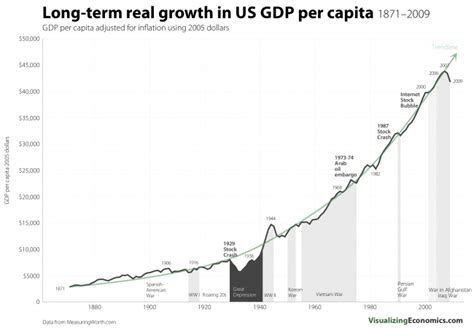The United States stands as a global economic powerhouse, boasting an impressive Gross Domestic Product (GDP) per capita that ranks among the highest in the world. GDP per capita measures the economic output of a country divided by its population, providing a comprehensive indicator of individual economic well-being.

Economic Snapshot: A Glimpse into US GDP Per Capita
1. Surpassing Global Benchmarks
According to the International Monetary Fund (IMF), the US GDP per capita reached a staggering $69,288 in 2022, eclipsing the global average of $11,911. This robust economic performance reflects the country’s advanced infrastructure, skilled workforce, and innovative technologies.
2. Historical Progression
Over the past few decades, US GDP per capita has witnessed a steady upward trajectory. From $41,344 in 1990, it has consistently increased, reaching its peak in 2022. This growth has been driven by technological advancements, globalization, and productivity gains.
Impact on Individual Well-being
1. Enhanced Living Standards
A high GDP per capita translates into improved living standards for individuals. It enables access to better healthcare, education, housing, and other essential amenities, fostering a higher quality of life.
2. Economic Empowerment
Higher per capita income enhances economic empowerment, empowering individuals to make informed financial decisions, plan for the future, and contribute to economic growth.
Drivers of Economic Success
1. Technological Prowess
The US is a global leader in technological innovation, boasting world-class research institutions and technology giants. This innovation-driven economy has spurred job creation, productivity gains, and economic expansion.
2. Human Capital
The US possesses a highly skilled and educated workforce, with a strong emphasis on higher education. This skilled labor force contributes significantly to productivity and economic competitiveness.
Challenges and Opportunities
1. Income Inequality
Despite its high GDP per capita, the US faces challenges related to income inequality, with a widening gap between the wealthy and the poor. Addressing this disparity requires policies that promote equitable wealth distribution.
2. Productivity Stagnation
The US has experienced a slowdown in productivity growth in recent years, which could impact future economic expansion. Investing in infrastructure, education, and technological advancements is crucial to overcome this hurdle.
Fostering Future Economic Growth
To sustain economic growth and prosperity, the US must focus on:
1. Innovation and Technology
Continued investment in research and development, fostering entrepreneurship, and promoting technology adoption will drive innovation and productivity.
2. Education and Workforce Development
Investing in education and workforce training programs will enhance the nation’s human capital, ensuring a skilled and adaptable workforce.
3. Infrastructure and Connectivity
Modernizing infrastructure, including transportation, energy, and communications, will facilitate economic activity and improve living standards.
4. Global Competitiveness
Maintaining a competitive edge in global markets by promoting innovation, investing in foreign trade, and strengthening international partnerships.
Tables for Further Analysis
Table 1: GDP Per Capita Comparison
| Country | GDP Per Capita (2022) |
|---|---|
| United States | $69,288 |
| Canada | $59,950 |
| Japan | $43,479 |
| United Kingdom | $47,335 |
| Australia | $56,326 |
Table 2: GDP Per Capita Growth
| Year | GDP Per Capita (Constant 2010 USD) | % Change |
|---|---|---|
| 2010 | $50,565 | – |
| 2015 | $56,417 | 11.6% |
| 2020 | $63,544 | 12.6% |
| 2022 | $69,288 | 9.2% |
Table 3: Income Inequality
| Income Percentile | Share of National Income |
|---|---|
| Bottom 20% | 3.8% |
| Middle 60% | 45.3% |
| Top 20% | 50.9% |
Table 4: Future Economic Drivers
| Sector | Drivers |
|---|---|
| Technology | Artificial intelligence, automation, quantum computing |
| Education | Personalized learning, lifelong learning, skills-based training |
| Healthcare | Personalized medicine, telemedicine, genomics |
| Green Economy | Renewable energy, sustainable infrastructure, clean transportation |
FAQs
1. What factors contribute to the high GDP per capita of the US?
Technological prowess, a highly skilled workforce, strong infrastructure, and globalization.
2. How does GDP per capita impact individual well-being?
It enhances living standards, provides access to essential amenities, and empowers economic decisions.
3. What are the key challenges facing US economic growth?
Income inequality, productivity stagnation, and global competition.
4. How can the US sustain economic prosperity in the future?
By investing in innovation, education, infrastructure, and global competitiveness.
5. What are some innovative ideas to drive future economic growth?
Personalized AI-powered healthcare, sustainable urban design, advanced manufacturing, and blockchain-based financial systems.
6. How can I contribute to increasing US GDP per capita?
Invest in education, pursue a career in a high-growth industry, support innovation, and engage in community development.



